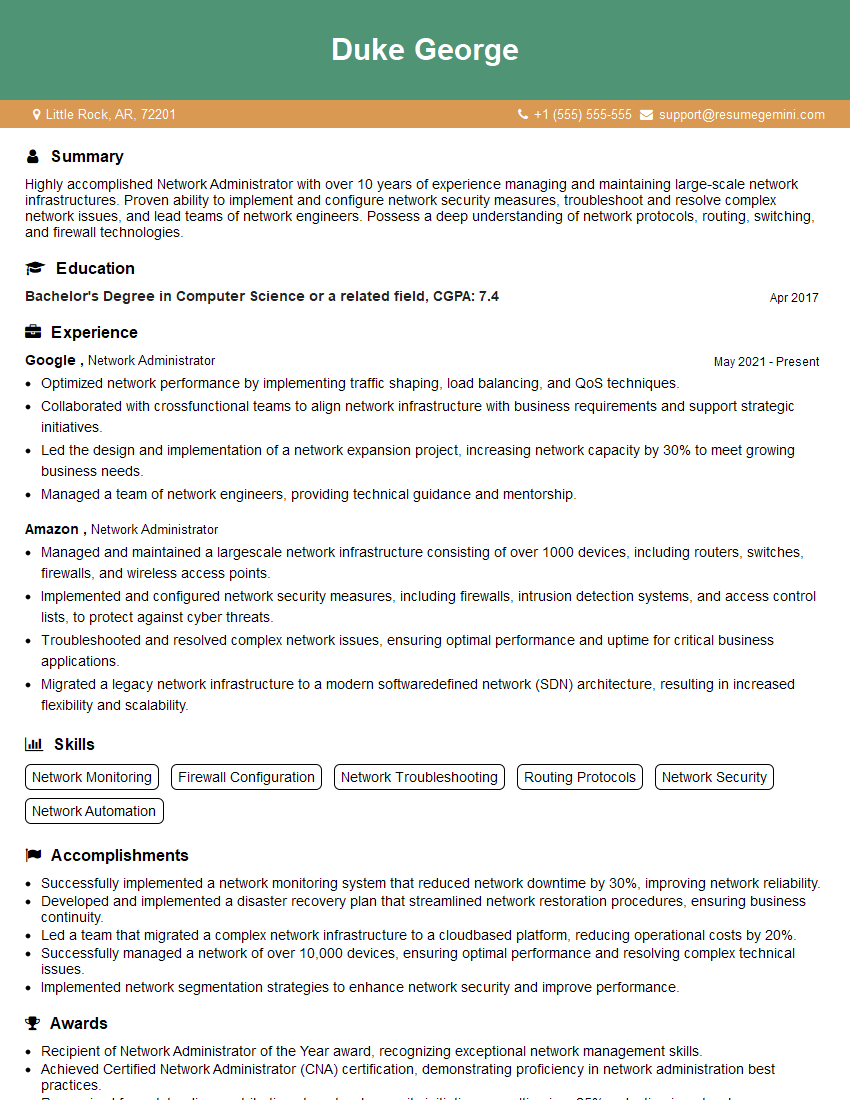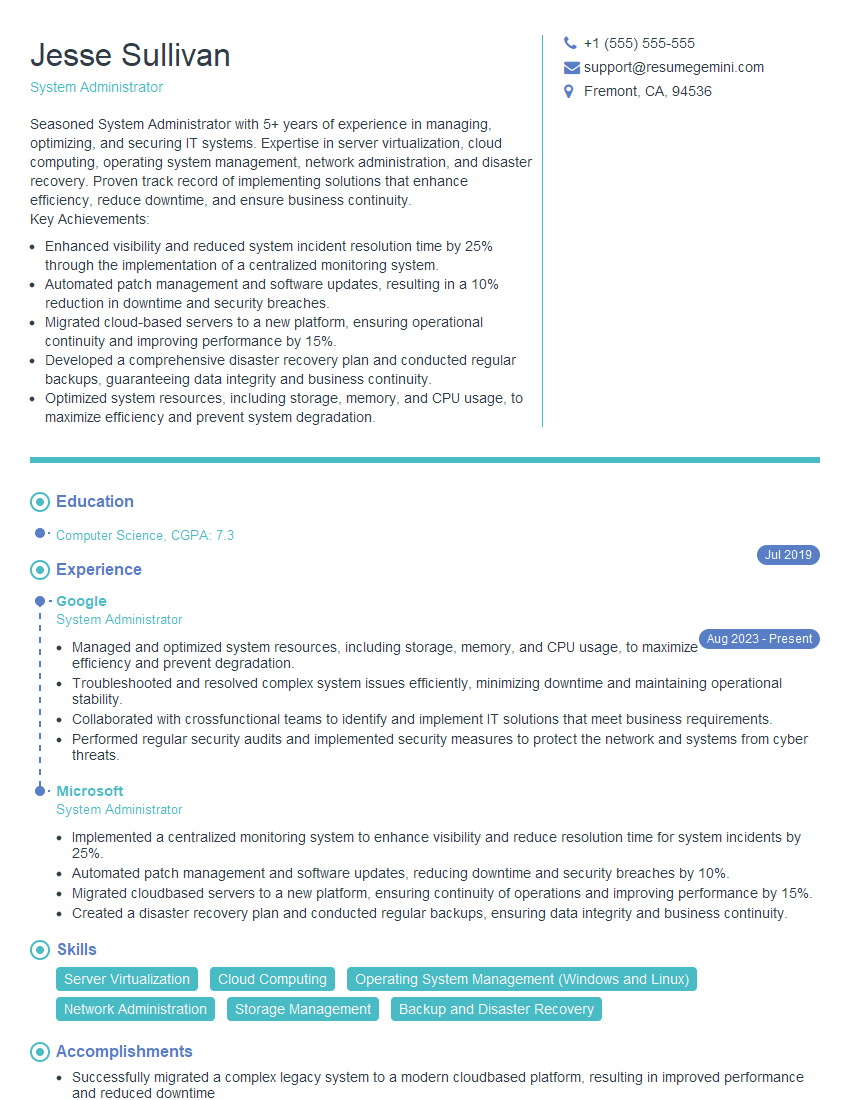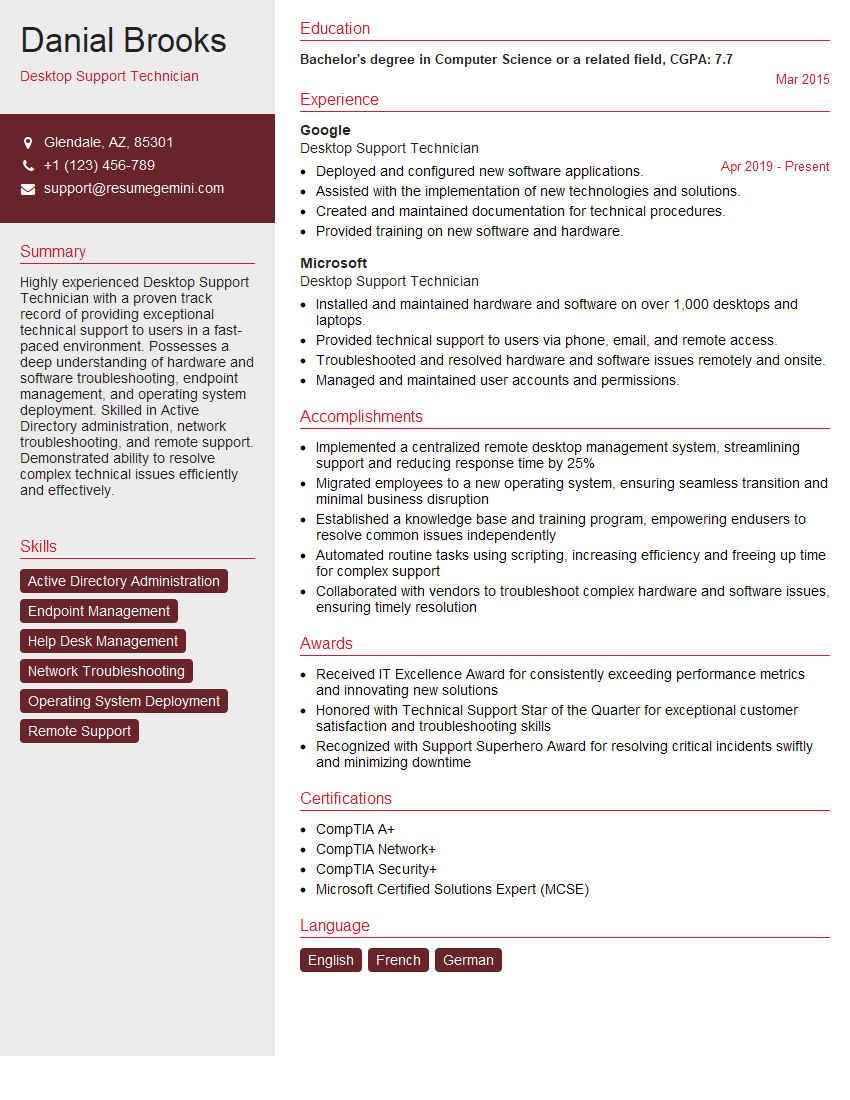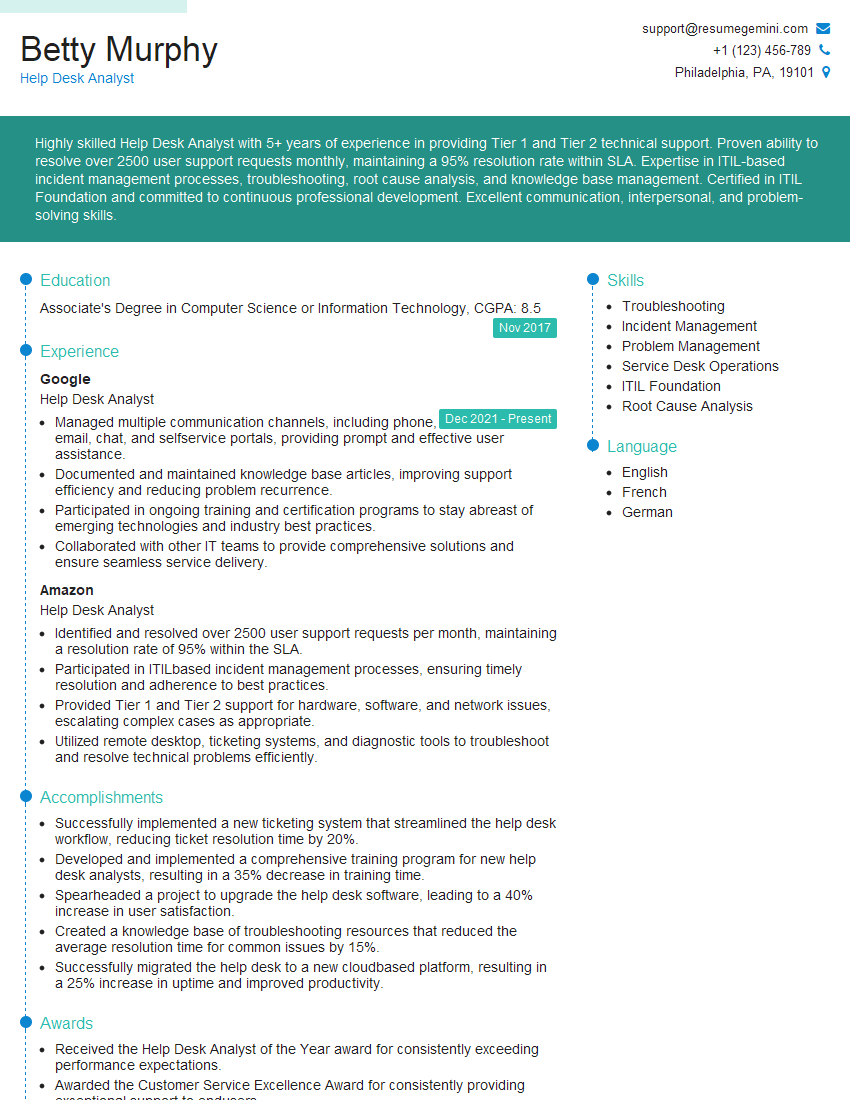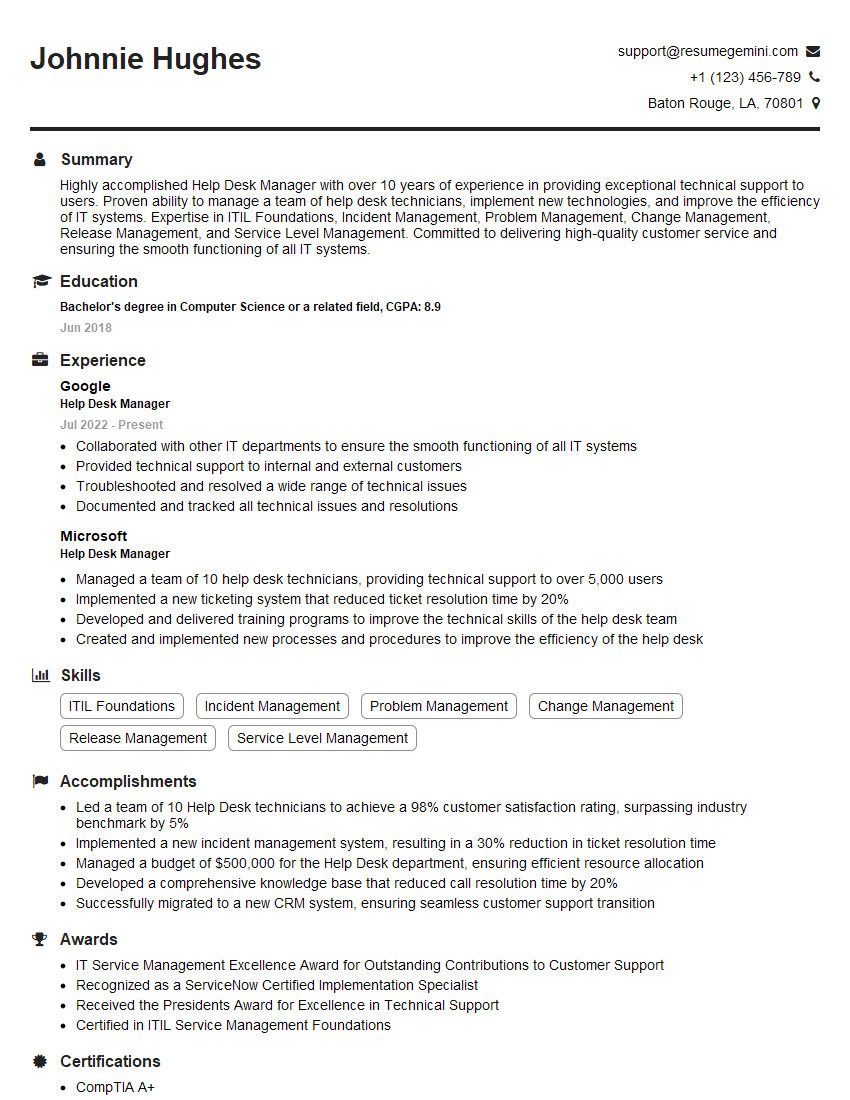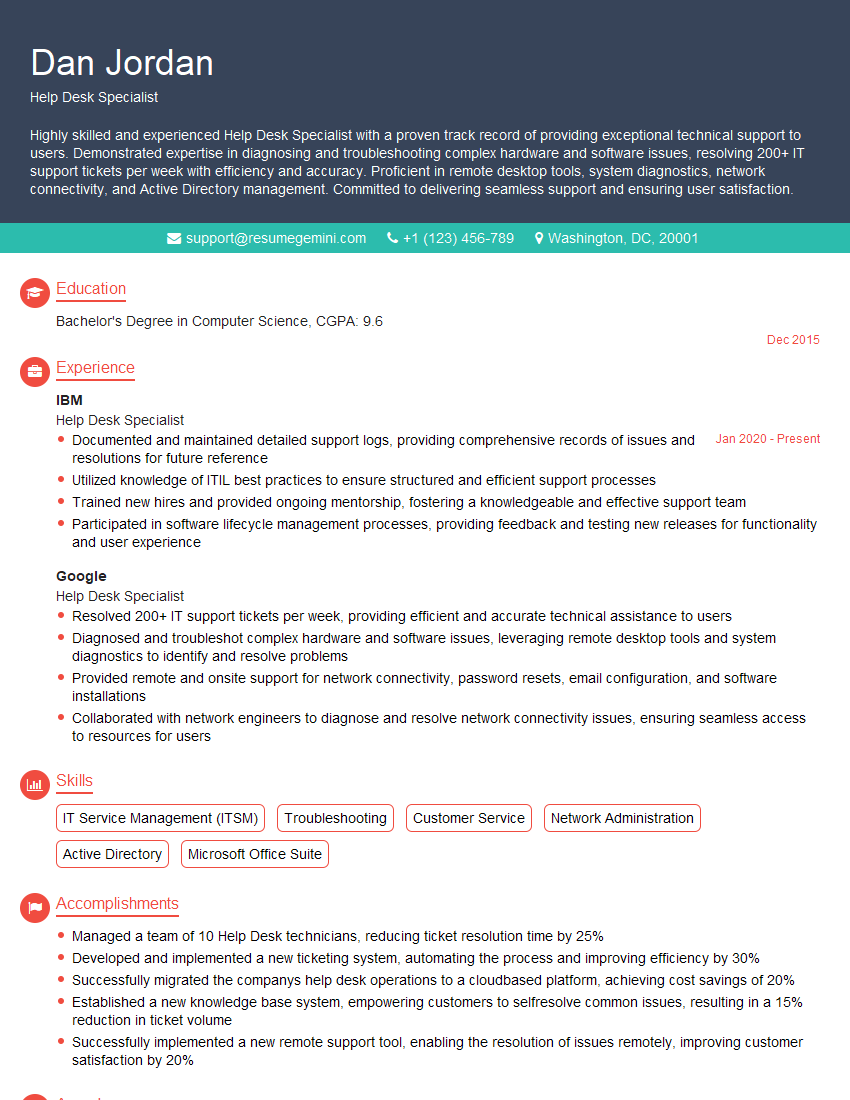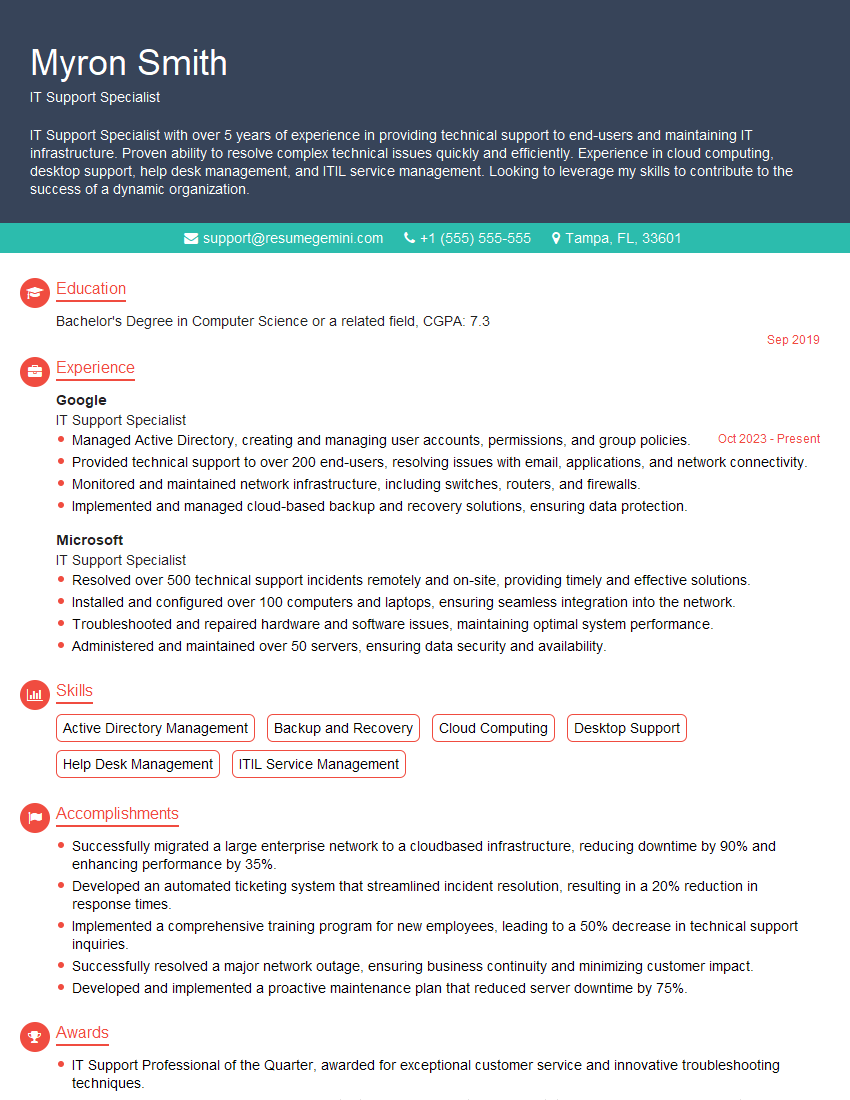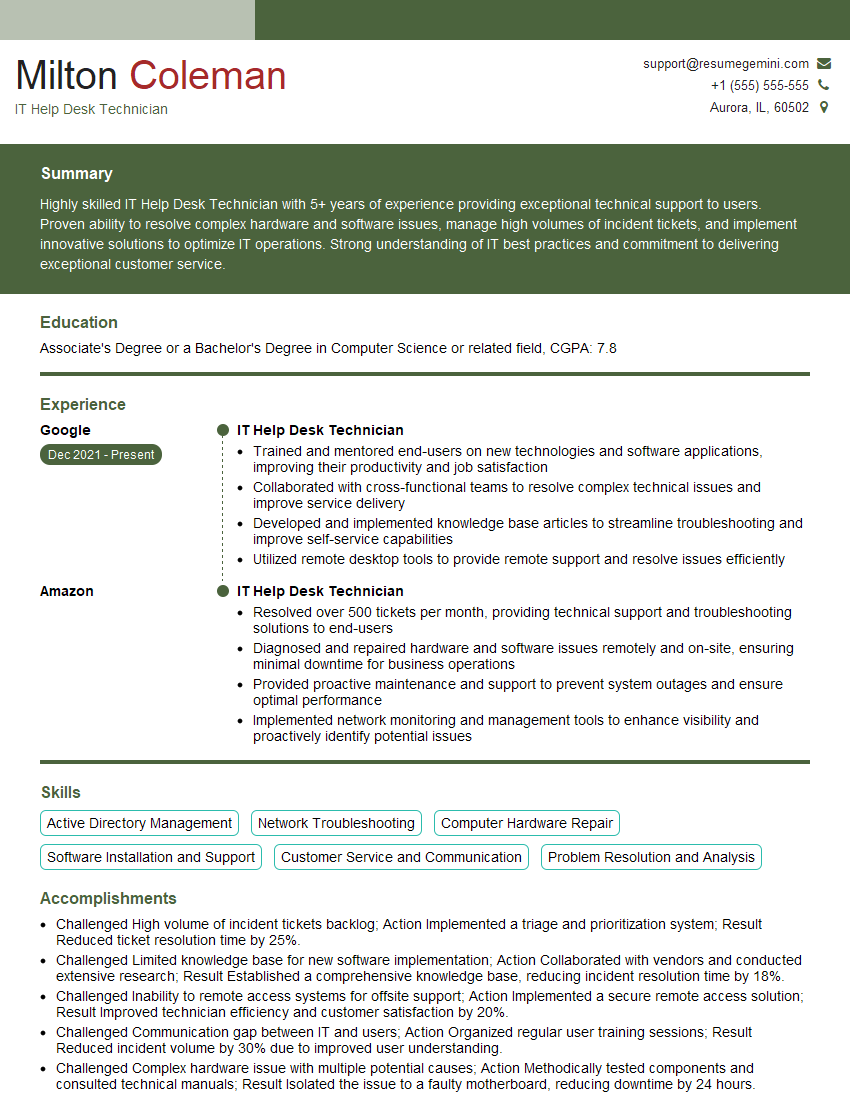The thought of an interview can be nerve-wracking, but the right preparation can make all the difference. Explore this comprehensive guide to Help Desk interview questions and gain the confidence you need to showcase your abilities and secure the role.
Questions Asked in Help Desk Interview
Q 1. Describe your experience troubleshooting common hardware issues.
Troubleshooting hardware issues involves a systematic approach combining technical knowledge and effective communication. I begin by gathering information from the user, asking clear and concise questions about the problem, the symptoms, and any recent changes to the system. This initial assessment helps narrow down the potential causes.
- Peripheral Problems: For instance, if a user reports their printer isn’t working, I’d first check the power cable, connection to the computer, and driver installation. I might ask if it’s working with other devices to isolate the problem to the printer, the cable, or the computer’s USB ports.
- Boot Issues: If a computer fails to boot, I’d systematically check the power supply, RAM, and hard drive. Listening carefully for unusual sounds during startup is also key. A beeping sequence, for example, often indicates a specific hardware fault, usually documented in the computer’s manual.
- Network Connectivity: Network problems often involve checking cable connections, verifying network settings (IP address, subnet mask, DNS server), and troubleshooting router/switch configurations. Pinging the default gateway is a basic network troubleshooting step.
Throughout the process, I meticulously document each step, the user’s feedback, and the resolution. This ensures efficient troubleshooting and provides valuable data for future reference. My experience allows me to quickly identify common problems and implement solutions effectively, minimizing downtime for users.
Q 2. How do you prioritize multiple support tickets with varying levels of urgency?
Prioritizing support tickets requires a clear understanding of urgency and impact. I utilize a system combining ticket categorization, severity levels, and service level agreements (SLAs). Tickets are categorized based on the affected system (e.g., email, network, application). Severity levels are defined by the impact of the issue on business operations, ranging from critical (system outage) to low (minor inconvenience).
I employ a combination of the following methods to prioritize tickets:
- Severity-Based Prioritization: Critical issues, such as a complete network outage, take precedence over low-severity issues like a slow-running application.
- SLA Compliance: I pay close attention to SLAs defined for different ticket types, ensuring timely resolution within established timelines. A ticket requiring a response within an hour will get immediate attention.
- Ticket Queuing System: Most ticketing systems automatically sort tickets based on urgency and assigned severity. This helps me systematically address them in the correct order.
Imagine a scenario where a critical server is down impacting all users, versus a user having trouble accessing a specific file. The server outage will undeniably be addressed first.
Q 3. Explain your process for escalating complex issues to senior technicians.
Escalating complex issues involves a structured process aiming for efficient resolution and knowledge sharing. The escalation process typically begins with documenting the issue comprehensively, including troubleshooting steps already attempted, user feedback, and relevant error messages or logs.
My approach to escalating includes:
- Clear Communication: I prepare a concise summary highlighting the problem’s nature, its impact, and the unsuccessful troubleshooting steps already taken.
- Relevant Information: I attach any relevant screen captures, logs, or diagnostic reports to provide a complete context to the senior technician.
- Prioritization: I clearly state the urgency of the issue, ensuring the senior technician understands the impact of delayed resolution.
- Follow-Up: After escalating, I follow up with the senior technician for updates, ensuring seamless collaboration.
For example, if I encounter a complex network configuration issue, after documenting my steps, I’d escalate to a senior network engineer, attaching network diagnostics and logs detailing failed attempts to resolve the problem. This process ensures a smooth handover and efficient resolution of intricate technical problems.
Q 4. What ticketing systems are you familiar with (e.g., Zendesk, ServiceNow)?
My experience encompasses several popular ticketing systems, including Zendesk, ServiceNow, and Jira Service Desk. Each system offers unique features, but my core skills in managing tickets, tracking resolution times, and managing user interactions remain consistent across platforms.
I am proficient in using these systems to:
- Create and Assign Tickets: Categorize and assign tickets based on the issue’s nature and the appropriate support team.
- Track Ticket Status: Monitor ticket progress, ensuring timely resolution and updates for users.
- Manage Knowledge Base: Contribute to and leverage the knowledge base to resolve recurring issues efficiently.
- Generate Reports: Utilize reporting features to analyze trends and improve support processes.
The specific functionalities and interfaces may differ, but the underlying principles of effective ticket management remain the same regardless of the specific platform used.
Q 5. How do you handle difficult or frustrated users?
Handling frustrated users requires patience, empathy, and effective communication skills. The key is to acknowledge their frustration, actively listen to their concerns, and assure them that you’re working to resolve the issue. I always aim to be calm, understanding, and professional, even when facing challenging situations.
My approach includes:
- Active Listening: I carefully listen to the user’s concerns without interrupting. I allow them to vent their frustration. Showing I understand their perspective is crucial.
- Empathetic Response: I acknowledge their frustration with statements like, “I understand this is frustrating,” or “I apologize for the inconvenience.”
- Clear Communication: I provide regular updates on the progress of the issue, explaining the steps being taken to resolve it. Transparency builds trust.
- Setting Realistic Expectations: If a resolution cannot be immediate, I set realistic expectations and communicate a timeline for resolution.
If the situation escalates beyond my capabilities, I politely explain the need to escalate the issue to a senior technician, assuring them I’ll keep them informed.
Q 6. Describe your experience with remote support tools.
I have extensive experience with various remote support tools, including TeamViewer, AnyDesk, and LogMeIn. These tools enable me to provide efficient and effective remote support to users, resolving issues without the need for on-site visits. I use these tools to:
- Remotely Access User Systems: Diagnose and resolve technical issues such as software glitches, driver problems, or connectivity issues. This often significantly reduces resolution time.
- Guide Users Through Troubleshooting Steps: I can visually guide users through tasks using screen sharing, making it easier for them to understand and implement solutions.
- Control User Systems Safely: I understand the importance of security and always adhere to security protocols when accessing user systems remotely. I avoid storing access credentials and follow company security policies.
For example, using TeamViewer, I can remotely access a user’s computer to install a necessary software update or diagnose a network connectivity problem, thereby providing immediate support and resolving the issue effectively and quickly.
Q 7. What are your strengths and weaknesses in a Help Desk environment?
My strengths in a Help Desk environment lie in my technical proficiency, problem-solving skills, and excellent communication abilities. I’m adept at diagnosing and resolving diverse technical issues, and I can quickly adapt to new technologies. I communicate effectively with users, regardless of their technical expertise, ensuring a positive user experience.
However, like anyone, I also have areas for development. One area I’m actively working on is enhancing my knowledge of emerging technologies and staying up-to-date with industry trends. While I have a broad understanding of many technologies, the pace of technological change necessitates ongoing learning.
Q 8. How do you stay updated on the latest technologies and troubleshooting techniques?
Staying current in the ever-evolving tech landscape is crucial for a Help Desk professional. My approach is multifaceted. I subscribe to several reputable technology newsletters and blogs, such as those from Microsoft, Google, and various cybersecurity firms, focusing on updates related to operating systems, network protocols, and common applications. I actively participate in online communities like Reddit’s r/sysadmin and Stack Overflow, engaging in discussions and learning from experienced professionals. Additionally, I dedicate time to online courses and webinars offered by platforms like Coursera, Udemy, and LinkedIn Learning, focusing on certifications relevant to my role, such as CompTIA A+, Network+, and Security+. Finally, I regularly review vendor documentation and knowledge bases for the software and hardware we support, ensuring I’m familiar with the latest troubleshooting procedures and best practices.
For example, recently, I completed a course on the latest Windows Server updates and its impact on Active Directory management, improving my efficiency in resolving related user issues. Continuous learning is not just about acquiring new skills, but also about refining existing ones to ensure I provide the most efficient and effective support.
Q 9. Explain your experience with Active Directory.
I possess extensive experience with Active Directory, having managed and maintained it for over five years. My responsibilities included user and group management, creating and modifying organizational units (OUs), implementing Group Policy Objects (GPOs) for security and software deployment, and troubleshooting authentication and authorization issues. I’m proficient in using Active Directory Users and Computers (ADUC) and Active Directory Domains and Trusts. I’ve also worked with Active Directory Certificate Services (AD CS) for deploying and managing digital certificates.
For instance, I once resolved a widespread login failure by identifying a misconfigured GPO that was preventing users from accessing network resources. This involved careful analysis of event logs, identifying the conflicting GPO, and then creating a new, correctly configured GPO to resolve the issue without causing further disruption. This experience highlights my ability to diagnose complex problems within Active Directory and implement efficient solutions.
Q 10. How familiar are you with network troubleshooting (TCP/IP, DNS)?
I have a strong understanding of network troubleshooting, encompassing TCP/IP and DNS. My experience includes diagnosing connectivity problems, resolving DNS resolution failures, and analyzing network traffic using tools like Wireshark. I understand the importance of IP addressing, subnetting, and routing in a network environment. I’m comfortable using command-line tools like ping, ipconfig, nslookup, and tracert to diagnose network issues.
A recent example involved a user who couldn’t access a specific website. Using nslookup, I quickly identified that the DNS server wasn’t resolving the domain name correctly. By checking the DNS server configuration and resolving the issue, I restored the user’s access promptly. My expertise in these areas allows me to efficiently troubleshoot network problems, minimizing downtime for users.
Q 11. Describe your experience with operating systems (Windows, macOS, Linux).
My experience spans across various operating systems, including Windows (all versions from XP to the latest), macOS, and Linux (primarily Ubuntu and CentOS). I’m comfortable performing installations, configurations, troubleshooting, and maintenance tasks on each platform. I understand the nuances of each OS, including their file systems, command-line interfaces, and security mechanisms. I’ve also worked with virtualization technologies like VMware and VirtualBox, managing virtual machines running different operating systems.
For instance, I recently helped a user recover data from a corrupted Windows partition using system recovery tools. On another occasion, I helped a developer set up a Linux server for a new project, guiding them through the installation and configuration of necessary software. This versatility allows me to assist a wide range of users with diverse technical needs.
Q 12. How do you document solutions and knowledge base articles?
Effective documentation is critical in a Help Desk environment. I utilize a structured approach to document solutions and knowledge base articles. My process typically starts with a clear and concise title that accurately reflects the issue. I then detail the steps to reproduce the problem, the troubleshooting steps I took, and the final solution implemented. I use screenshots, error messages, and code snippets where appropriate to enhance understanding. For knowledge base articles, I also include preventative measures or best practices to avoid similar issues in the future. I maintain consistency in formatting and terminology to ensure easy searchability and accessibility for other team members.
I usually employ a wiki-style system or a ticketing system with a robust knowledge base feature, allowing for easy updates and version control. This ensures that information remains accurate and up-to-date. The key is to create documentation that is easily understandable by both technical and non-technical users.
Q 13. What is your experience with IT security best practices?
I adhere to robust IT security best practices. This includes understanding and implementing policies around password management, access control, data encryption, and incident response. I’m familiar with common security threats like phishing, malware, and ransomware. I understand the importance of regular software updates and patching to minimize vulnerabilities. My experience also includes working with security tools like antivirus software, firewalls, and intrusion detection systems.
For example, I’ve played a key role in educating users about phishing scams and implementing security awareness training programs to reduce the risk of social engineering attacks. I’ve also participated in incident response activities, helping to contain and mitigate security breaches, ensuring data integrity and user safety.
Q 14. How do you handle situations where you don’t know the answer to a user’s question?
When confronted with an unknown issue, I employ a structured approach to problem-solving. First, I actively listen to the user, gathering as much information as possible about the problem. I then try to reproduce the issue myself, if possible. Next, I leverage available resources, such as online forums, vendor documentation, and internal knowledge bases. I may also consult with senior team members or escalate the issue to a specialist if needed. Throughout this process, I maintain clear communication with the user, keeping them updated on my progress and setting realistic expectations. My goal is to find a solution or at least provide a temporary workaround to minimize disruption to the user.
Transparency and effective communication are key. It’s better to admit you don’t know the immediate answer than to provide incorrect information. The ability to effectively research and escalate problems is just as important as knowing the answer immediately.
Q 15. Describe your experience with troubleshooting network connectivity issues.
Troubleshooting network connectivity issues is a cornerstone of help desk support. It involves systematically identifying the root cause of a user’s inability to connect to the network, internet, or other devices. My approach is methodical, starting with the simplest checks and progressing to more complex diagnostics.
- First-level checks: I begin by confirming the obvious – is the device powered on? Are cables properly connected? Is Wi-Fi enabled and showing a strong signal? I often ask users to restart their devices, a surprisingly effective first step.
- Intermediate troubleshooting: If the basic checks fail, I move to more specific troubleshooting. This could involve checking IP configuration (
ipconfig /allon Windows,ifconfigon Linux/macOS), ensuring DNS resolution is working correctly (using a command likeping google.com), and verifying firewall settings aren’t blocking network access. I might also check for network driver updates or conflicts. - Advanced troubleshooting: In more complex cases, I might utilize network monitoring tools to analyze traffic, packet loss, or latency. This could involve working with network engineers to identify problems at the infrastructure level, such as router issues or network outages. For example, I’ve successfully resolved issues caused by faulty network switches by carefully reviewing network logs and collaborating with the network team.
I always document my troubleshooting steps thoroughly, helping me track progress and ensure efficient resolution. For recurring issues, I proactively investigate the underlying cause and propose preventative solutions.
Career Expert Tips:
- Ace those interviews! Prepare effectively by reviewing the Top 50 Most Common Interview Questions on ResumeGemini.
- Navigate your job search with confidence! Explore a wide range of Career Tips on ResumeGemini. Learn about common challenges and recommendations to overcome them.
- Craft the perfect resume! Master the Art of Resume Writing with ResumeGemini’s guide. Showcase your unique qualifications and achievements effectively.
- Don’t miss out on holiday savings! Build your dream resume with ResumeGemini’s ATS optimized templates.
Q 16. Explain your experience with printer troubleshooting and configuration.
Printer troubleshooting and configuration is another area where I possess significant experience. It encompasses everything from setting up new printers to resolving print jobs failures, connectivity issues, and driver problems.
- Installation and Configuration: I’m proficient in installing network printers, both locally and across domains, using various protocols like TCP/IP, LPD, and others. I guide users through the process of adding printers via the operating system’s control panel or dedicated print management software. I’m comfortable working with different printer brands and models, and can configure settings like paper size, duplex printing, and print quality.
- Troubleshooting Print Issues: When troubleshooting, I first check the printer’s physical status (paper jams, toner levels, etc.). Then, I investigate the print queue for any errors or stalled jobs. I’m skilled in diagnosing driver conflicts and resolving them by reinstalling or updating drivers, checking printer port settings, and troubleshooting network connectivity between the printer and the client machines.
- Example: Once, a user experienced intermittent printing errors. By carefully checking the print spooler logs, I identified a driver issue and by updating the printer driver, resolved the problem permanently.
I strive to provide clear, step-by-step instructions to users, and often utilize screenshots and remote assistance tools to guide them through the process effectively. I also maintain a list of frequently asked printer questions and solutions which significantly reduces resolution times.
Q 17. How do you handle situations where a user’s problem is caused by their own actions?
When a user’s problem stems from their actions, my approach is to provide constructive feedback while maintaining a professional and empathetic demeanor. My goal is not to blame but to educate and prevent future occurrences.
- Understanding the Root Cause: I begin by patiently listening to the user and asking clarifying questions to understand exactly what they did that led to the issue. This helps avoid misunderstandings and ensures I address the core problem.
- Calm and Patient Explanation: I explain the consequences of their actions clearly and without judgment. I might use analogies or simple explanations to make the technical details easier to grasp. For instance, if a user accidentally deleted important files, I’ll explain the importance of proper file management and backups.
- Provide Solutions and Preventative Measures: I guide them through the process of resolving the immediate problem. Crucially, I also teach them how to avoid similar issues in the future, perhaps by recommending better practices or suggesting relevant training resources.
For instance, if a user inadvertently downloaded malware, I would not simply remove the malware but also explain safe browsing habits, the importance of antivirus software, and how to identify phishing attempts.
Q 18. What is your experience with software installation and configuration?
Software installation and configuration are routine tasks for me. My experience encompasses a wide range of software, from operating systems and productivity suites to specialized applications. I’m adept at handling both standard installations and more complex deployments.
- Standard Installations: I regularly install and configure applications like Microsoft Office, Adobe Creative Suite, and various other business applications. This involves following the installer’s instructions, setting appropriate permissions, and configuring settings to meet user needs.
- Advanced Installations: I’m also comfortable with more complex installations, such as configuring server software, installing and configuring databases (MySQL, PostgreSQL etc.), and deploying applications in virtual environments. This may require understanding registry settings, modifying configuration files, or using command-line tools.
- Troubleshooting Installations: I’m skilled at troubleshooting installation problems, such as driver conflicts, permission errors, and dependency issues. I understand how to interpret error messages and utilize diagnostic tools to find the root cause of installation failures.
I always adhere to best practices, including creating system restore points before major installations and meticulously documenting each step to ensure reproducibility and facilitate future troubleshooting. I am equally comfortable working with both GUI and command-line installation methods.
Q 19. Describe your experience with password resets and account management.
Password resets and account management are integral aspects of help desk support. I’m proficient in handling various account-related issues, ensuring security and maintaining user access.
- Password Resets: I’m experienced in implementing secure password reset procedures, ensuring that only authorized users can regain access to their accounts. This typically involves verifying user identity through various methods, such as security questions or multi-factor authentication.
- Account Creation and Modification: I create new user accounts, configure their access permissions, and modify existing accounts as needed, always adhering to company security policies. This includes setting appropriate access levels, granting permissions to specific resources, and managing group memberships.
- Account Lockouts: I’m skilled in handling account lockouts, determining the cause (too many failed login attempts), and assisting users in regaining access without compromising security. This often involves reviewing account activity logs and coordinating with security teams.
My approach prioritizes security. I meticulously document all account changes and adhere to strict protocols to minimize the risk of unauthorized access or data breaches. I regularly update my knowledge of security best practices to ensure that our account management procedures remain secure and compliant.
Q 20. How do you ensure data security and privacy while providing support?
Data security and privacy are paramount in my work. I always adhere to company policies and best practices to protect sensitive information.
- Confidentiality: I never disclose user information to unauthorized individuals. I only access user data on a need-to-know basis and always maintain strict confidentiality.
- Data Protection: I follow established procedures for handling sensitive data, such as securely deleting data when it’s no longer needed and encrypting data when transmitted or stored.
- Compliance: I ensure that my actions comply with all relevant data protection regulations and company policies. This includes understanding and adhering to regulations like GDPR or CCPA where applicable.
- Secure Remote Access: When providing remote support, I always use secure connections (such as VPNs) to protect the user’s data and prevent unauthorized access.
I regularly update my knowledge of security threats and vulnerabilities to maintain a high level of awareness and proficiency in protecting user data. I believe that safeguarding user information is not just a technical process but a fundamental ethical responsibility.
Q 21. What is your experience with using a knowledge base or help documentation?
I have extensive experience using knowledge bases and help documentation. I see them as indispensable tools for providing efficient and consistent support.
- Self-Service Support: I understand that well-structured knowledge bases empower users to solve many problems independently. I contribute to and maintain our knowledge base, ensuring that it’s up-to-date, accurate, and easy to navigate. I create clear, concise articles and use appropriate keywords to make information easily searchable.
- Troubleshooting: I regularly consult knowledge bases to find solutions to problems that I haven’t encountered before. I use them as a valuable resource for troubleshooting complex issues and understanding best practices.
- Internal Collaboration: I use the knowledge base to share my solutions and troubleshooting steps with colleagues, improving team knowledge and efficiency. This collaborative approach fosters continuous improvement and ensures that we can handle a broader range of issues effectively.
I believe that a well-maintained knowledge base is a crucial element of a successful help desk strategy. It empowers both users and support staff, leading to faster resolution times, improved user satisfaction, and a more efficient overall support process.
Q 22. How do you handle repetitive tasks efficiently?
Efficiency in a Help Desk role hinges on minimizing repetitive tasks. I achieve this through a multi-pronged approach. First, I meticulously document solutions. If I solve a recurring issue, I create a knowledge base article or update an existing one, complete with screenshots and step-by-step instructions. This ensures that the next time the issue arises, I (or another technician) can quickly resolve it using the documented solution.
Second, I leverage automation wherever possible. Many Help Desk systems allow for scripting or the use of automation tools. For example, if a user frequently requests password resets, I might explore setting up a self-service password reset portal, reducing my manual workload. Third, I prioritize training users. Often, repeated issues stem from a lack of understanding. By proactively offering tutorials or creating short, helpful guides, I prevent problems before they even occur. This is particularly effective for common issues like printer troubleshooting or software installation. For instance, I could create a short video tutorial showing how to correctly install a specific piece of software. Finally, I regularly review my tasks to identify patterns and areas where process improvement is needed.
Q 23. Describe a time you had to deal with a particularly challenging technical problem.
During my previous role, we experienced a widespread network outage that affected nearly half our company’s users. Initial diagnostics pointed to a router failure, but replacing the router didn’t resolve the issue. The challenge was exacerbated by the pressure of numerous frantic calls and the looming deadline of an important client presentation. I systematically ruled out hardware failures, meticulously checking cables, power supplies, and server configurations. After hours of troubleshooting, I discovered a misconfiguration in the network’s firewall rules that was inadvertently blocking crucial network traffic. The solution involved a careful adjustment of the firewall rules, requiring precise knowledge of network security protocols. After implementing the fix, the network was restored, preventing significant financial and reputational damage. This experience taught me the importance of methodical troubleshooting, even under immense pressure, and the value of consulting documentation and colleagues when necessary.
Q 24. How do you maintain a professional and helpful demeanor under pressure?
Maintaining professionalism and helpfulness under pressure is paramount in a Help Desk environment. I approach stressful situations with a structured, calming methodology. First, I actively listen to the user, acknowledging their frustration and validating their concerns. This simple act often de-escalates tension. Second, I maintain a calm and clear tone of voice, even if I am feeling stressed internally. Speaking slowly and clearly ensures the user understands my instructions. Third, I focus on problem-solving, actively engaging the user in the process, involving them in solutions. If the problem requires more time to resolve, I proactively communicate this clearly, setting realistic expectations. Think of it like a doctor – patients appreciate clear communication and a plan of action, even if the outcome takes time. Finally, I actively utilize de-escalation techniques, offering empathy and understanding. This creates a positive experience for the user, even if the resolution is delayed. Remember, a positive interaction leaves a lasting impression.
Q 25. What are your salary expectations for this Help Desk position?
Based on my experience and research of similar roles in this region, my salary expectations are in the range of $55,000 to $65,000 annually. However, I am flexible and willing to discuss this further based on the complete benefits package and the specifics of the role.
Q 26. What are your long-term career goals in IT?
My long-term career goals in IT involve leveraging my Help Desk experience to transition into a Systems Administrator role. I want to expand my skills in network administration, server management, and cloud technologies. Ultimately, I aspire to contribute to a company’s overall IT infrastructure, ensuring its smooth operation and security. My goal is to move from reactive problem-solving to proactive system management and optimization.
Q 27. Why are you interested in this specific Help Desk role?
I am particularly drawn to this Help Desk role because of [Company Name]’s reputation for innovation and its commitment to employee development. The opportunity to work with [mention specific technologies or projects] aligns perfectly with my professional goals, and the emphasis on teamwork and collaboration resonates strongly with my preferred work style. The description of the role highlighted a focus on continuous learning and professional growth, which is extremely appealing to me.
Q 28. Do you have any questions for me?
Yes, I have a few questions. First, what are the company’s plans for professional development and training for Help Desk personnel? Second, could you describe the team dynamic and the level of collaboration involved in the role? And third, what are the company’s primary IT support tools and technologies?
Key Topics to Learn for Help Desk Interview
- Troubleshooting Techniques: Understanding common hardware and software issues, methodical problem-solving approaches (e.g., using the five whys), and documenting troubleshooting steps.
- Ticketing Systems: Familiarity with various ticketing systems (e.g., Zendesk, Jira Service Desk), understanding their workflows, and best practices for ticket management (prioritization, escalation, closure).
- Operating Systems & Applications: Proficiency in common operating systems (Windows, macOS, Linux) and applications (Microsoft Office Suite, Google Workspace). Demonstrate practical experience with these tools.
- Networking Fundamentals: Basic understanding of network concepts like IP addresses, DNS, TCP/IP, and troubleshooting network connectivity issues. Knowing how to explain technical concepts in simple terms is key.
- Remote Assistance & Collaboration Tools: Experience with remote support tools (TeamViewer, AnyDesk) and collaboration platforms (Slack, Microsoft Teams) to effectively assist users remotely.
- Customer Service & Communication: Highlight your skills in active listening, clear communication (written and verbal), empathy, and de-escalating stressful situations. Preparing examples of successful customer interactions is beneficial.
- Security Awareness: Understanding basic security protocols, password management, phishing awareness, and data protection best practices. Showcase your commitment to secure practices.
- Problem-Solving & Critical Thinking: Emphasize your ability to analyze problems logically, identify root causes, and develop effective solutions. Use examples from past experiences to illustrate your skills.
Next Steps
Mastering Help Desk skills is crucial for a rewarding and progressive IT career. It builds a strong foundation for roles in IT support, systems administration, and other related fields. To significantly increase your job prospects, create an ATS-friendly resume that highlights your key accomplishments and skills effectively. ResumeGemini is a trusted resource that can help you build a professional resume that stands out to recruiters. Examples of resumes tailored to the Help Desk role are available to guide you through the process.
Explore more articles
Users Rating of Our Blogs
Share Your Experience
We value your feedback! Please rate our content and share your thoughts (optional).
What Readers Say About Our Blog
Hi, I’m Jay, we have a few potential clients that are interested in your services, thought you might be a good fit. I’d love to talk about the details, when do you have time to talk?
Best,
Jay
Founder | CEO
